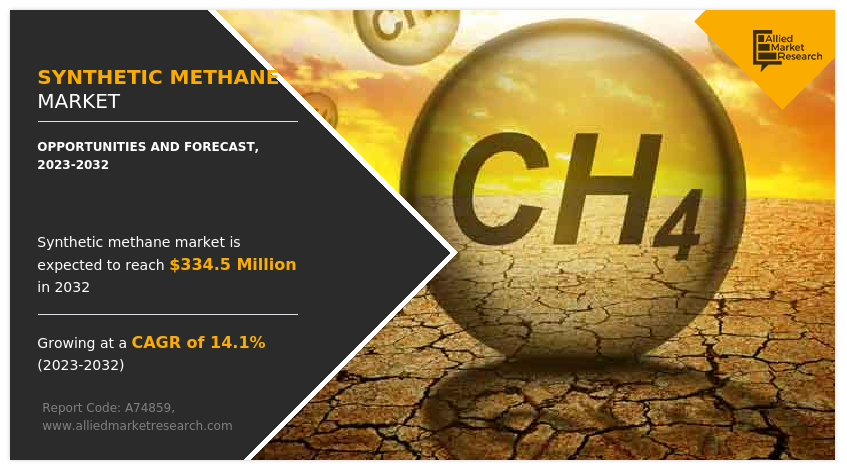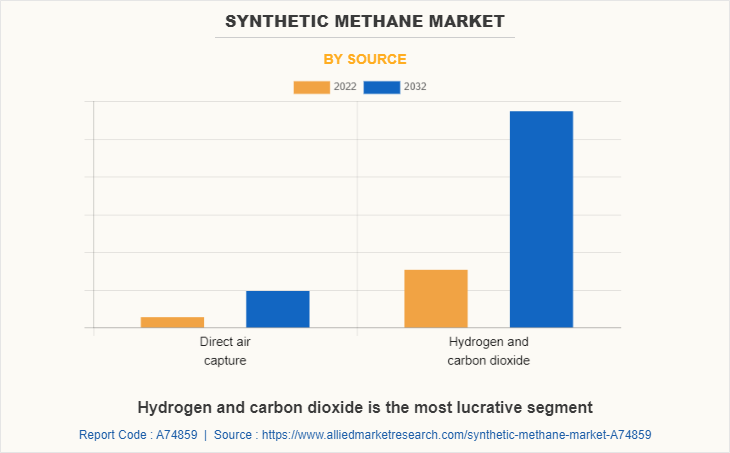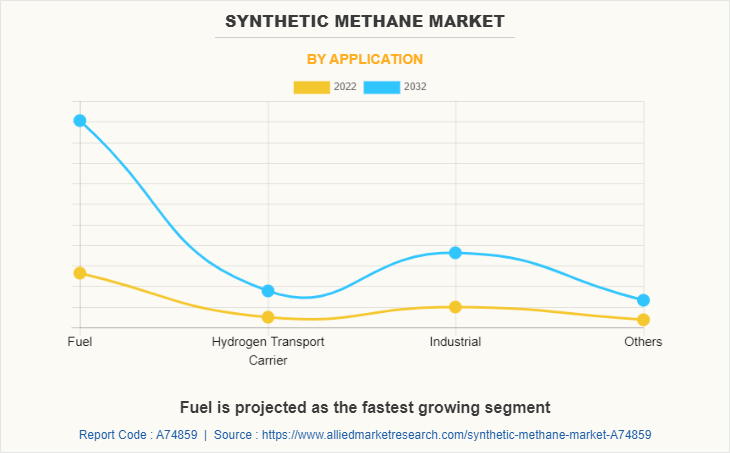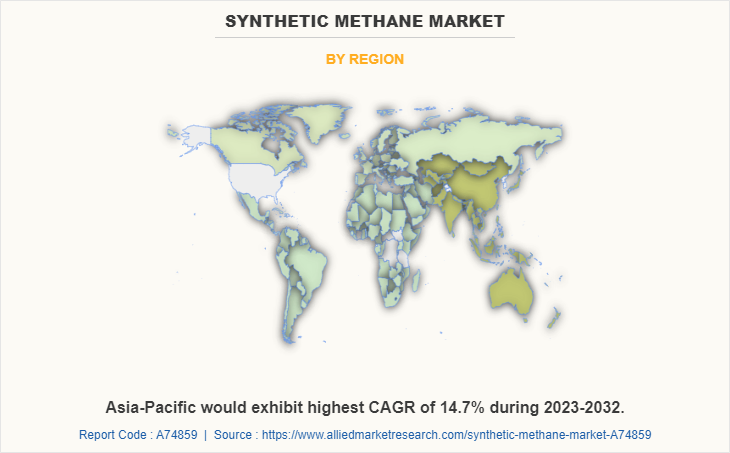Synthetic Methane Market Research, 2032
The global synthetic methane market was valued at $89.7 million in 2022, and is projected to reach $334.5 million by 2032, growing at a CAGR of 14.1% from 2023 to 2032.
Report Key Highlighters
- The report provides competitive dynamics by evaluating business segments, product portfolios, target market revenue, geographical presence and key strategic developments by prominent manufacturers.
- The synthetic methane market is consolidated in nature among prominent companies such as CLARIANT, Air Liquide, TransTech Energy, LLC, OSAKA GAS CO.,LTD, Zentrum für Sonnenenergie- und Wasserstoff-Forschung Baden-Württemberg, Dakota Gasification Company, and Mitsubishi Corporation,.
- The study contains qualitative information such as the market dynamics (drivers, restraints, challenges, and opportunities), key regulation analysis, pricing analysis, and Porter’s Five Force Analysis across North America, Europe, Asia-Pacific, LAMEA regions.
- Latest trends in global synthetic methane market such as undergoing R&D activities, regulatory guidelines, and government initiatives are analyzed across 16 countries in 4 different regions.
- More than 3,000 synthetic methane-related product literatures, industry releases, annual reports, and other such documents of key industry participants along with authentic industry journals and government websites have been reviewed for generating high-value industry insights for global synthetic methane market.

Synthetic methane, also known as methane gas or synthetic natural gas (SNG), is a renewable or synthetic form of methane that can be produced through various processes. It shares the same chemical formula as natural gas, which is CH4 (one carbon atom bonded to four hydrogen atoms). However, synthetic methane is produced from non-fossil fuel sources or through carbon capture technologies, making it a potential low-carbon alternative to natural gas.
Decarbonizing gas infrastructure is crucial for achieving climate goals, promoting renewable energy integration, improving air quality, enhancing energy security, and driving innovation & job creation in the clean energy sector. It is an essential step in the transition toward a more sustainable and low-carbon energy system.
Synthetic methane can be injected into existing natural gas infrastructure, including pipelines and storage facilities, without requiring significant modifications. This makes it an attractive option for decarbonizing the gas grid and utilizing the existing infrastructure for renewable energy distribution. This factor fuels the growth of the synthetic methane market for decarbonization purposes.
Moreover, energy storage and grid balancing are essential for the effective integration of renewable energy, ensuring grid stability, managing peak demand, optimizing grid operations, and facilitating the transition to a more sustainable and decentralized energy system.
Synthetic methane can be produced by converting renewable electricity into hydrogen through electrolysis and then combining it with carbon dioxide. This process, known as power-to-gas, enables the storage of excess renewable energy generated during peak periods and its subsequent conversion back into electricity or heat when needed. It provides a means for balancing the intermittent nature of renewable energy sources and ensuring a stable energy supply, which, in turn, boosts the growth of the synthetic methane market.
However, the production of synthetic methane is more expensive compared to natural gas extracted from fossil fuel sources. The process of converting renewable electricity into hydrogen through electrolysis, capturing carbon dioxide, and combining them to produce methane can be cost-intensive. As a result, the cost competitiveness of synthetic methane limits its widespread adoption. This acts as a significant constraint of the global synthetic methane market.
On the contrary, improvements in synthetic methane production process are expected to create lucrative opportunities for research and innovation. For instance, advances in electrolysis, methanation, carbon capture, and other related processes can enhance efficiency, reduce costs, and increase the scalability of synthetic methane production. These advancements can drive down production costs, making synthetic methane more economically viable and competitive. This factor may increase the demand for synthetic methane, thus creating remunerative opportunities for the market.
The global synthetic methane market is segmented into source, application, and region. On the basis of source, the market is categorized into direct air capture and hydrogen and carbon dioxide. Depending on application, it is divided into fuel, hydrogen transport carrier, industrial, and others. Region -wise, the market is studied across North America, Europe, Asia-Pacific, and LAMEA.

In 2022, the hydrogen and carbon dioxide segment was the largest revenue generator, and is anticipated to grow at a CAGR of 14.2% during the forecast period. The production of synthetic methane from hydrogen and carbon dioxide offers a means of utilizing CO2 as a feedstock and converting renewable hydrogen into a versatile energy carrier. It enables the integration of renewable energy sources into existing natural gas infrastructure and provides a pathway for decarbonization in sectors that heavily rely on natural gas. Moreover, increase in utilization of carbon and hydrogen for producing synthetic methane may enhance the carbon capturing activities, thus reducing the global carbon footprint. This factor is the major key market trend in the synthetic methane market for hydrogen and carbon dioxide source.

By application, the fuel segment dominated the global market in 2022, and is anticipated to grow at a CAGR of 14.4% during forecast period. The use of synthetic methane as a fuel offers several advantages, including reduced greenhouse gas emissions, compatibility with existing natural gas infrastructure, and versatility across different sectors. However, it is important to ensure the production of synthetic methane is sourced from renewable energy and that proper infrastructure and safety measures are in place to support its utilization as a fuel. This factor may act as a key driver responsible for the growth of the synthetic methane market for fuel applications. Moreover, the government of both developed and developing economies are increasingly focusing on production of synthetic fuels such as bio-diesel and synthetic methane. This may further augment the demand for synthetic methane market for fuel applications.

The Asia-Pacific synthetic methane market size is projected to grow at the highest CAGR of 14.7% during the forecast period and accounted for 50.7% of synthetic methane market share in 2022. China has a high demand for energy, and it is constantly seeking to diversify its energy sources to reduce dependence on imported fossil fuels. Synthetic methane, produced from renewable sources or through carbon capture and utilization (CCU) technologies, offers a domestically producible and sustainable energy option, which can enhance China's energy security and reduce reliance on imported fuels. This fuels the growth of the synthetic methane market in the region.
In addition, India has diverse energy needs, including rural electrification and decentralized energy solutions, wherein synthetic methane plays a role in meeting these requirements. It can be produced locally from various sources such as agricultural waste, biomass, or solar power, providing clean and reliable energy options for off-grid or remote areas where infrastructure for traditional energy sources may be limited. Thus, the abovementioned factors boost the growth of the synthetic methane market in Asia-Pacific.
The global synthetic methane market profiles leading players that include CLARIANT, Air Liquide, Terega, TransTech Energy, LLC, OSAKA GAS CO.,LTD, Zentrum für Sonnenenergie- und Wasserstoff-Forschung Baden-Württemberg, Dakota Gasification Company, Mitsubishi Corporation, KADATEC s.r.o., and MAN Energy Solutions. The global synthetic methane market report provides in-depth competitive analysis as well as profiles of these major players.
IMPACT OF COVID-19 ON THE GLOBAL SYNTHETIC METHANE MARKET
- The pandemic has led to a decline in energy demand in many parts of the world due to lockdowns, travel restrictions, and economic slowdown. As a result, the demand for synthetic methane, which is primarily used as a fuel or feedstock, was negatively impacted.
- However, factors such as government policies for the promotion of synthetic fuels, sustainability goals, and investments in clean energy technologies have fueled the growth of the synthetic methane market post pandemic.
Key Benefits For Stakeholders
- This report provides a quantitative analysis of the market segments, current trends, estimations, and dynamics of the synthetic methane market analysis from 2022 to 2032 to identify the prevailing synthetic methane market opportunities.
- The market research is offered along with information related to key drivers, restraints, and opportunities.
- Porter's five forces analysis highlights the potency of buyers and suppliers to enable stakeholders make profit-oriented business decisions and strengthen their supplier-buyer network.
- In-depth analysis of the synthetic methane market segmentation assists to determine the prevailing market opportunities.
- Major countries in each region are mapped according to their revenue contribution to the global market.
- Market player positioning facilitates benchmarking and provides a clear understanding of the present position of the market players.
- The report includes the analysis of the regional as well as global synthetic methane market trends, key players, market segments, application areas, and market growth strategies.
Synthetic Methane Market Report Highlights
| Aspects | Details |
| Market Size By 2032 | USD 334.5 million |
| Growth Rate | CAGR of 14.1% |
| Forecast period | 2022 - 2032 |
| Report Pages | 434 |
| By Source |
|
| By Application |
|
| By Region |
|
| Key Market Players | Dakota Gasification Company, MAN Energy Solutions, KADATEC s.r.o., TransTech Energy, LLC, Terega, Mitsubishi Corporation, Air Liquide, Zentrum für Sonnenenergie- und Wasserstoff-Forschung Baden-Württemberg, OSAKA GAS CO.,LTD, CLARIANT |
Analyst Review
As per the insights of the CXOs of the leading companies, the global synthetic methane market is expected to exhibit high growth potential, owing to factors such as rapid energy integration, carbon capture & utilization, sector decarburization, energy storage, and flexibility of utilization. Synthetic methane offers a pathway to achieve sustainable development and climate goals. By reducing reliance on fossil fuels and enabling the utilization of renewable or captured carbon dioxide resources, the synthetic methane industry can contribute to mitigating climate change and fostering a sustainable energy transition. Thus, synthetic methane is gaining high traction in the recent years.
The CXOs further added that several countries and regions have set ambitious decarbonization targets to combat climate change. Synthetic methane offers a viable pathway to reduce greenhouse gas emissions, as it can be produced from renewable sources or through carbon capture and utilization technologies. It can replace conventional fossil fuels such as natural gas or diesel in various sectors, enabling the achievement of decarbonization goals.
Furthermore, the CXOs stated that sustained economic growth coupled with rapid development of power generation sector is likely to foster the growth of the synthetic methane market.
Increase in transition in renewable energy, decarbonization of gas infrastructure, and energy security and grid balancing are the upcoming trends of the synthetic methane market.
The leading applications of synthetic methane market includes fuel, hydrogen transport carrier, industrial, and others.
Asia-Pacific is the largest regional market for the synthetic methane market.
The synthetic methane market valued for $89.7 million in 2022 and is estimated to reach $334.5 million by 2032, exhibiting a CAGR of 14.1% from 2023 to 2032.
CLARIANT, Air Liquide, Terega, TransTech Energy, LLC, OSAKA GAS CO.,LTD, Zentrum für Sonnenenergie- und Wasserstoff-Forschung Baden-Württemberg, Dakota Gasification Company, Mitsubishi Corporation, KADATEC s.r.o., and MAN Energy Solutions are the top companies to hold the market share in the synthetic methane market.
Loading Table Of Content...
Loading Research Methodology...



